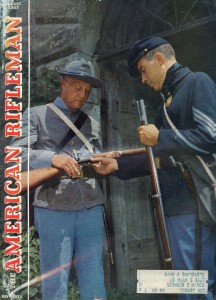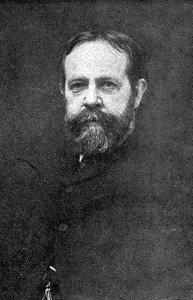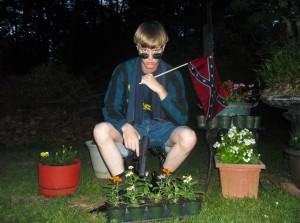Civil War memory and American gun culture
10 November 2015 – Thomas J. Brown

The cover illustration of The American Rifleman for August 1957 featured members of the North-South Skirmish Association, founded in 1950. Source: Author’s collection
Ashley Halsey Jr. was frustrated when the civil rights movement defeated the Lost Cause. The United States Civil War Centennial Commission had invited the Saturday Evening Post associate editor and Civil War buff to be the featured speaker at the 1961 centennial commemoration of the firing on Fort Sumter in his hometown of Charleston, South Carolina. The event exploded in controversy because a local hotel refused to accommodate an African American delegate to the assembly. The John F. Kennedy administration moved the meeting to a nearby naval base, which led delegates from former Confederate states to secede from the event in protest.
Chosen as speaker for his sense of humor, Halsey lost his temper at the breakaway banquet and launched into a rant against Abraham Lincoln and the contemporary North. A few years later, he left the Saturday Evening Post and became the editor of American Rifleman, an organ of the National Rifle Association (NRA). There the veteran of the North-South Skirmish Association, a hobbyist group focused on marksmanship with Civil War era weaponry, fought to defeat efforts to enact new gun control legislation following the assassination of John F. Kennedy.
This trajectory was revealing. Whatever Halsey’s mix of motives for his new venture may have been, the gun-rights movement offered him replacements for the psychological and political satisfactions that the declining public credibility of the Lost Cause had taken away. His tale invites re-examination of the relationship between Civil War memory and the importance of the gun in American culture (a topic distinct from Michael Bellesiles’s controversial argument that the war dramatically expanded civilian gun ownership).

William Conant Church, co-founder of the National Rifle Association, hoped the organization would instill some of the military discipline he had seen in the war. Image credit: Wikimedia Commons
The commemorative connection is longstanding. The NRA, founded in 1871 by two Union veterans, was almost as direct an institutional expression of early postwar remembrance as the Grand Army of the Republic. One of its co-founders, William Conant Church, was the editor of The Army and Navy Journal, intended as a long-term newspaper link between civilian readers and what Church hoped would be a permanently strengthened military establishment. “For the future, we are a military people,” he wrote in the inaugural issue of August 29, 1863. But by 1871 he was moaning that traditional American aversion to the military had revived immediately upon demobilization. Church’s co-founder George Wood Wingate was a regimental officer in his state militia, a long embattled institution that was pursuing a rebranding after the war as the National Guard. For these men, the NRA offered a vehicle to promote the social discipline that they thought the Union Army had modeled for the nation.
Early leadership of the NRA further illustrated its Civil War origins. The first president was former rifle manufacturer and Union general Ambrose Burnside. His year-long presidency, concurrent with his term as commander-in-chief of the GAR, bridged his elections as Rhode Island governor and United States senator and foreshadowed NRA alliances in the gun industry and politics. Subsequent NRA presidents included U. S. Grant and Philip Sheridan. The Confederate foundations of postwar gun culture were even deeper, preceding secession in the slave-South origins of laws permitting white citizens to carry weapons in public.
Ashley Halsey’s career points toward an affinity between more recent gun culture and the version of Confederate memory that emerged from the collapse of the Lost Cause. The leadership of this commemoration has been overwhelmingly male, in contrast with the previous influence of the United Daughters of the Confederacy and earlier Ladies Memorial Associations. Its political style is populist, a departure from Lost Cause reinforcement of class hierarchy. In place of quasi-religious practices like Memorial Day observances or monument dedications, it has embraced commercial leisure activities, such as Civil War reenactors’ purchase of simulated uniforms and period equipment.
The emblem of the new Confederate memory, the battle flag that South Carolina raised at its state house in 1961 in protest against federal integration of the centennial gathering in Charleston, shares important features with the gun as an element of the American imagination. As the battle flag was long prominent in school athletics and professional stock-car racing, guns are central to the recreational pastimes of hunting and target-shooting. The banner of secession has sparked fervor among self-defined rebels of many stripes, and recent defense of the standard has maintained that it means only what any individual chooses for it to mean. Privately owned weapons are similarly fundamental to libertarian fantasies of self-empowerment in a lawless society or grassroots overthrow of a supposedly tyrannical government. The Confederate battle flag and the personal gun are also both popular forms for expression of white racism in the United States, although of course many individuals display battle flags or own guns for other reasons.

Dylann Roof posted this photograph of himself on his website, lastrhodesian.com. Photo credit: Internet Archive
The removal of the Confederate battle flag from the South Carolina state house has been the centerpiece in a reassessment of racially inflected symbols prompted by white supremacist Dylann Roof’s murder of nine African Americans at Emanuel AME Church in Charleston. Major retailers’ decisions to stop selling flag-related merchandise showed how much recent Confederate commemoration has depended on commerce. The reassessment has also turned to older remembrances, including civic monuments and the names of buildings, parks, streets, and institutions.
As much as these forms of commemoration call for reconsideration in particular cases, public discussion should not exaggerate the vitality of stale Lost Cause remnants and should recognize that Confederate memory circulates within a broad repertory of political images. The gun is vastly more potent in contemporary national discourse than Confederate iconography. Historians have understandably been eager to respond to the Charleston murders by building on research that has exposed the pernicious legacy of the Lost Cause and the use of the Confederate battle flag to rally opponents of civil rights. That effort should also recall Ashley Halsey’s example and apply the insights and methods of scholarship on Civil War memory to confront the most virulent symbol in American life today.
~ Thomas J. Brown is professor of history at the University of South Carolina and the author of Civil War Canon: Sites of Confederate Memory in South Carolina (University of North Carolina Press, 2015).



